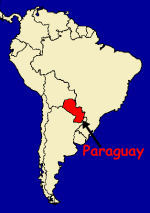This charcoal was recommended to us by one of our readers.

Aspidosperma quebracho-blanco |
They spoke of hard, dense charcoal with lots of reasonably-sized peices.
 So we popped on over to Amazon which carries this charcoal (free shipping with Prime!) and ordered a bag.
So we popped on over to Amazon which carries this charcoal (free shipping with Prime!) and ordered a bag.
Harder Charcoal is made in Paraguay (see the map at left) next to the Chaco Forest along the border of Argentina by a German family that
emigrated there in 1947. The charcoal is made from a South American wood called Quebracho Blanco, a wood we have run into a few times before.
If you are wondering about the word "quebracho," it is derived from quiebrahacha, or quebrar hacha, meaning "axe-breaker".
As for a description of the wood, we get this from Wikipedia:
"Quebracho blanco wood is uniformly yellow-ochre, without differences between hardwood and sapwood. It is quite heavy
(relative density = 0.885 g/cm³) and hard, and responds well to bending and shock. Upon drying it tends to collapse, producing deformations and cracks,
so the drying process is slow; the wood must be treated with fungicides. It is easy to work and has many uses in carpentry (carts, wheels, floors, shoes,
tool handles, furniture); it is also good for chess pieces, skis, etc. Preserved with creosote it can be used outdoors. In some places it is widely
used as coal, since it does not produce sparks or large amounts of ash, and it burns strong and slowly."
Deforestation is a serious issue in the Chaco, so it is good to know that all of their charcoal has been ethically,
legally, and fairly sourced utilizing only forest leftovers. They claim they have never cut a single
tree to create their charcoal. More information about their process can be found on their website.
Let's move on now to seeing how this charcoal performs. The first thing we do is to dump the bag out
onto the ground and sort it into large, medium, and small pieces, as well as the chips and dust at the
bottom of the bag. We found one rock the size of a large golfball, but no scrap, trash or other
undesirable items. The charcoal itself is very very dense. (We'll see in a bit if this denseness
translates to the long burn times that so many folks seem to think results from dense charcoal.) Here is what we found
in the way of size distribution:
| Large |
10.3 pounds |
31.2% |
| Medium |
12.4 pounds |
37.8% |
| Small |
8.6 pounds |
26.1% |
| Chips/Dust |
1.6 pounds |
4.9% |
|
|
|
| Total |
32.9 pounds |
|
|
As we said, we found one rock about the size of a large golf ball in the bag. If you include the weight of the
rock, the bag was just barely over the advertised weight. If you omit the rock, the bag was just barely
under the advertised weight. Otherwise, the distribution of sizes was exceptional. Even the small pieces
were on the large side. There was very little waste in this bag.
In our lighting test, Harder Charcoal took 4 sheets of newspaper to get started. This is average compared to
other brands we have tested. There was no sparking or popping while the charcoal was lighting. The smell of
the charcoal is moderate and pleasant. One thing we did note that we don't usually see is that some of the
charcoal burned with a yellow flame rather than just glowing red until it gets really hot and then burning with a pale
blue flame. This indicates that the charcoal was cooked to a lower temperature than most and thus less of the
volatile components of the wood were driven off.
Harder Charcoal certainly burns hot. In our maximum temperature test, it hit 1229°F which is a new world record
for us. Needless to say this is very high compared to all other brands. Also, the fire spread very quickly after
we dumped the charcoal into a cooker and then added more for the test.
Next we come to the burn time test. There were no sparks or pops when lighting with a MAP/Pro torch, but as always,
exercise care when using a torch of any kind to start lump charcoal. The burn time for Harder Charcoal was only
average when compared to other brands, which again dispels the myth that denser charcoal burns longer. We have seen
this over and over. Dense charcoal doesn't burn that long and some less dense charcoals can burn nearly forever.
And finally we come to the ash results. The amount of ash produced per hour of burn time by Harder Charcoal was average when compared
to other brands.
So to sum up, with Harder Charcoal we have a charcoal that is moderately easy to light, burns extremely hot, but only has an
average burn time and produces an average amount of ash. However, you get quite a bit for your money as the size distribution
was excellent with a very low amount of unusable chips and dust. We give Harder Charcoal our Above Average rating.

